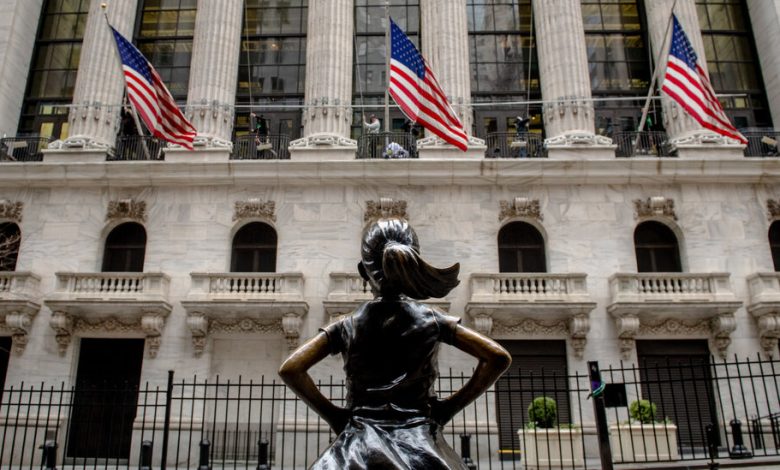Wall Street Is Counting on a Debt Limit Trick That Could Entail Trouble

Washington’s debt limit drama has Wall Street betting that the United States will employ a fallback option to ensure it can make good on payments to its lenders even if Congress doesn’t raise the nation’s borrowing limit before America runs out of cash.
But that untested idea has significant flaws and has been ruled out by the Biden administration, which could make it less of a bulwark against disaster than many investors and politicians are counting on.
Many on Wall Street believe that the Treasury Department, in order to avoid defaulting on U.S. debt, would “prioritize” payments on its bonds if it could no longer borrow funds to cover all its expenses. They expect that America’s lenders — the bondholders who own U.S. Treasury debt — would be first in line to receive interest and other payments, even if it meant delaying other obligations like government salaries or retirement benefits.
Those assumptions are rooted in history. Records from 2011 and 2013 — the last time the U.S. tipped dangerously close to a debt limit crisis — suggested that officials at the Treasury had laid at least some groundwork to pay investors first, and that policymakers at the Federal Reserve assumed that such an approach was likely. Some Republicans in the House and Senate have painted prioritization as a fallback option that could make failure to raise the borrowing cap less of a disaster, arguing that as long as bondholders get paid, the U.S. will not experience a true default.
But the Biden administration is not doing prioritization planning this time around because officials don’t think it would prevent an economic crisis and are unsure whether such a plan is even feasible. The White House has not asked Treasury to prepare for a scenario in which it pays back investors first, according to multiple officials. Janet L. Yellen, the Treasury secretary, has said such an approach would not avoid a debt “default” in the eyes of markets.
“Treasury systems have all been built to pay all of our bills when they’re due and on time, and not to prioritize one form of spending over another,” Ms. Yellen told reporters earlier this month.
Perhaps more worrisome is that, even if the White House ultimately succumbed to pressure to prioritize payments, experts from both political parties who have studied the temporary fix say it might not be enough to avert a financial catastrophe.
“Prioritization is really default by another name,” said Brian Riedl, formerly chief economist to former Republican Senator Rob Portman and now an economist at the Manhattan Institute. “It’s not defaulting on the government’s debt, but it’s defaulting on its obligations.”
Congress must periodically raise the nation’s debt ceiling to authorize the Treasury to borrow to cover America’s commitments. Raising the limit does not entail any new spending — it is more like paying a credit-card bill for spending the nation has already incurred — and it is often completed without incident. But Republicans have occasionally attempted to attach future spending cuts or other legislative goals to debt limit increases, plunging the United States into partisan brinkmanship.
Understand the U.S. Debt Ceiling
What is the debt ceiling? The debt ceiling, also called the debt limit, is a cap on the total amount of money that the federal government is authorized to borrow via U.S. Treasury securities, such as bills and savings bonds, to fulfill its financial obligations. Because the United States runs budget deficits, it must borrow huge sums of money to pay its bills.
The limit has been hit. What now? America hit its technical debt limit on Jan. 19. The Treasury Department will now begin using “extraordinary measures” to continue paying the government’s obligations. These measures are essentially fiscal accounting tools that curb certain government investments so that the bills continue to be paid. Those options could be exhausted by June.
What is at stake? Once the government exhausts its extraordinary measures and runs out of cash, it would be unable to issue new debt and pay its bills. The government could wind up defaulting on its debt if it is unable to make required payments to its bondholders. Such a scenario would be economically devastating and could plunge the globe into a financial crisis.
Can the government do anything to forestall disaster? There is no official playbook for what Washington can do. But options do exist. The Treasury could try to prioritize payments, such as paying bondholders first. If the United States does default on its debt, which would rattle the markets, the Federal Reserve could theoretically step in to buy some of those Treasury bonds.
Why is there a limit on U.S. borrowing? According to the Constitution, Congress must authorize borrowing. The debt limit was instituted in the early 20th century so that the Treasury would not need to ask for permission each time it had to issue debt to pay bills.
Today’s debt limit episode could be especially fraught, much like the 2011 episode that tiptoed the nation so close to the brink of default that America’s credit rating was downgraded for the first time. House Republicans have made clear that they want to attach spending stipulations in exchange for raising the borrowing cap, while the White House has said that it will not negotiate.
President Biden and Speaker Kevin McCarthy of California are expected to discuss the debt limit on Wednesday.
The drama is likely to escalate this summer. The government hit its debt limit on Jan. 19, and the Treasury Department has said that it can use temporary measures to keep covering expenses until at least June. After those are exhausted, the debt limit must be raised or suspended in order for the United States to borrow money to pay its bills.
“The odds of Treasury missing a payment — which is normally unthinkable — are higher than they have been in many years,” said Alec Phillips, an economist at Goldman Sachs. Mr. Phillips thinks a last-minute deal will be struck, but like many of his colleagues at big banks and asset managers, he has been studying what could happen if one is not.
The Fed, Treasury and industry groups have in the past made contingency plans addressing what they could do if payments on bonds were missed or delayed — including central bank purchases of defaulting bonds.
But those were last-ditch options. Transcripts and other documents from 2011 and 2013 show that officials assumed it was most likely that bondholders would be paid back first if the government did not have enough money to cover all its bills — which is why investors expect a prioritization plan if there is a debt limit breach.
“Prioritization is the linchpin of calmness,” said Ralph Axel, an interest rate strategist at Bank of America, explaining that he believes avoiding an outright default could mitigate the fallout of a debt ceiling breach in bond and stock markets. “Markets will come to expect a prioritization plan much more than they did in 2011.”
Several investors noted that the White House had no reason to acknowledge prioritization planning in public, since doing so could reduce the pressure for lawmakers to negotiate, but they still considered it the most likely outcome.
“I am not concerned about a bond default,” said Ajay Rajadhyaksha, the global chairman of research at Barclays who served on a Treasury borrowing advisory committee until 2022. “This has been settled in the past.”
Many Republicans also take it as a given that prioritization of debt payments would happen, and believe it would help to mute any market reaction.
“There is a pretty sizable group that thinks as long as we are current on our bond obligations, we’re basically fine,” said Michael Strain, director of economic policy studies at the American Enterprise Institute, said of Republicans in the House of Representatives.
“They do not adequately appreciate the risk of that course of action,” he added.
Republicans in the House have been developing legislation — which is unlikely to pass — that would direct Treasury to carry out some payments, including those on the debt, while delaying others. But the Biden administration has firmly ruled out the idea that it would put payments on the government’s debt first. Administration officials say privately that the political optics of choosing to favor bondholders over recipients of government aid would be anathema to Mr. Biden.
“This so-called ‘prioritization’ scheme makes Republicans’ priorities pretty clear — crystal clear, if I may add,” Karine Jean-Pierre, the White House press secretary, said on Jan. 17. “They want to put wealthy bondholders over ordinary Americans who want safe food, safe skies, safe communities and secure borders.”
Attempting to prioritize payments would carry severe political, practical and legal risks. Paying back bondholders might be critical to protecting the bedrock of financial markets, but it would put the administration in the position of looking like it was supporting wealthy investors over retirees, disability beneficiaries and military personnel.
It could also be subject to legal challenges, given that the executive branch would be deciding which congressional spending decisions to ignore and which ones to carry out. That could call into question “the balance of power between Congress and the president over spending priorities and the potential for use of prioritization in ways that Congress might not intend,” according to a Congressional Research Service analysis published in 2015.
And it might not even work. In 2011, officials had made rough plans for a very straightforward version of prioritization. But the Treasury worried about its ability to prioritize payments within its own systems if it needed to cherry-pick between a range of obligations, rather than just repaying interest and principle on debt while delaying everything else. Fed staff members thought the department could figure it out given time, based on transcripts from that August.
But “it’s something that until you have developed the procedures and tested the procedures, your comfort level is pretty low,” said Louise Roseman, a former Fed staff member who was working with Treasury on contingency planning. The Fed serves as the government’s banker and so it would have helped carry out the prioritized payments.
Even after contingency planning in the 2013 showdown, a top Treasury official called prioritization “entirely experimental” and said it carried “unacceptable risk.”
It also remains unclear whether prioritization would actually avert a financial meltdown. Markets may still balk in response to any breach of the debt limit that meant the United States could not make good on its obligations, whether it was an official bond default or not.
Mr. Phillips at Goldman Sachs pointed out that if the government was holding back payments to state and local authorities or other entities to make good on its debt, for instance, problems could ricochet through other debt markets.
Still, many on Wall Street — including Mr. Phillips — think prioritization would be likely if push came to shove because it could avoid some of the worst possible outcomes.
Credit default swaps, which provide insurance for bondholders in case borrowers fail to pay them back, would not be triggered. Rating agencies might also look more kindly on America’s situation: S&P, which downgraded U.S. debt in 2011, said it would only consider the U.S. to be in default if it failed to pay lenders. Moody’s, another rating agency, said it expected a deal to be struck but added that if the government failed to reach an agreement, debt would be prioritized “over all other payments.”
Still, most doubt that prioritization’s workability will be tested at all. Both Moody’s and S&P have left their assessments of the United States unchanged, expecting a deal to be struck.
“We are sticking our necks out,” said Joydeep Mukherji, the primary credit rating analyst for the United States at S&P. “If we are wrong, it will be the biggest mistake we have ever made.”





